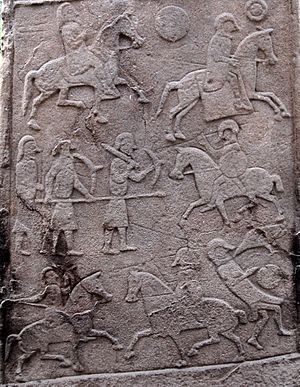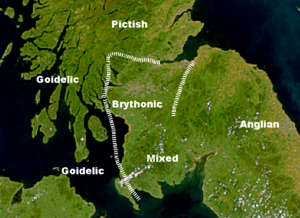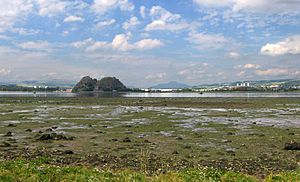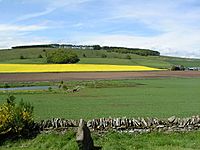Bridei son of Beli facts for kids
Quick facts for kids Bridei son of Beli |
|
|---|---|

The battle scene from the Aberlemno 2 Pictish stone, which may show the Battle of Dun Nechtain; Picts on the left, Northumbrians on the right, the mounted Pictish figure perhaps representing King Bridei
|
|
| King of the Picts and of Fortriu | |
| Reign | 671–692 |
| Predecessor | Drest son of Donuel |
| Successor | Taran son of Ainftech |
| Born | by 628 |
| Died | 692 |
| Burial | Iona Abbey |
| Father | Beli I of Alt Clut |
| Mother | Unknown daughter of Edwin of Northumbria |
Bridei son of Beli (died 692) was a powerful king of the Picts and of Fortriu from 671 to 692. His time as king marked a big change in the history of Scotland. Under Bridei, the different Pictish groups started to unite. This led to a strong Pictish kingdom that covered most of the lands north of the Forth.
Bridei likely grew up in the court of Northumbria, a powerful kingdom of the Angles in northern Britain. His father was Beli, king of the British kingdom of Alt Clut. His mother was probably a daughter of Edwin of Northumbria, a Northumbrian king.
Bridei became king of Fortriu with the help of King Ecgfrith of Northumbria. This happened after the previous Pictish king, Drest son of Donuel, was removed in 671. Drest had led a rebellion against Northumbrian rule. However, Bridei soon started to expand his own power. Between 679 and 683, he brought many Pictish areas together. This led to a conflict with King Ecgfrith. In 685, Ecgfrith led his army north into Pictish lands. This ended in the famous Battle of Dun Nechtain. Bridei's forces defeated the Northumbrians, and King Ecgfrith was killed.
Bridei's victory at Dun Nechtain ended Northumbrian control over the Picts. It also gave him strong control over a large area. After this, the idea of the Picts as a single people under one ruler grew stronger. This important process continued under later kings, including Bridei's likely grandchildren, Bridei son of Der-Ilei and Naiton son of Der-Ilei.
Contents
Who Were the People of Scotland?
Different Groups in Ancient Scotland
Before the Viking raids in the late 700s, the land we now call Scotland was home to four main groups of people. These groups had different cultures and spoke different languages. They were the Gaels of Dál Riata, the Britons, the Angles, and the Picts. However, these groups often changed and mixed over time.
The Gaels lived in the west of modern Scotland, north of the Firth of Clyde. They were part of a larger Gaelic culture that included Ireland. The Britons lived in several kingdoms in the south. These included Alt Clut near the River Clyde and the Gododdin near Edinburgh. In the southeast, the Angles had a kingdom called Bernicia. By 638, they had taken Edinburgh and much of the Gododdin lands. The Picts mostly lived in the east of modern Scotland, north of the Forth. They were a diverse group who had never been part of the Roman Empire.
The Pictish Lands
The Pictish lands were split into two parts by the Mounth. This is a chain of high mountains that reaches almost to the North Sea. The Pictish lands were also divided into smaller areas, some of which were kingdoms. The most important of these was Fortriu. It was located north of the Mounth, around the Moray Firth. Its main royal center was probably at Burghead. This fort was much larger than any other similar site in early medieval Scotland.
Between 653 and 685, the Picts were under the control of the powerful Northumbrian kingdom. Northumbria used "puppet kings" to rule the Picts. This means they put kings in power who would follow Northumbrian orders. The southern Pictish lands might have been an Anglo-Pictish area. A Northumbrian noble named Beornhæth might have ruled there.
Bridei's Family and Early Life
His Family Background
Bridei was known as the "son of the king of Dumbarton." This means his father was Beli, the king of Alt Clut. Alt Clut was a British kingdom. This also made Bridei the grandson of Beli's father, Neithon son of Guipno. Bridei was also the brother or half-brother of Beli's successor, Eugein.
A poem suggests that Bridei's fight with Ecgfrith of Northumbria was about Neithon's legacy. This hints that Bridei's grandfather, Neithon, might have been the same person as an earlier Pictish king, Nechtan nepos Uerb. This could mean Bridei's family had Pictish roots.
Another old text says that Bridei was King Ecgfrith's maternal first cousin. This means Bridei's mother was likely a daughter of King Edwin of Northumbria. She would have been a half-sister to the Northumbrian princess Eanflæd. The marriage of Bridei's parents probably helped Northumbria spread its influence into the lands of the Picts and the Britons.
Growing Up in Northumbria
Bridei was born by 628. His father, Beli of Alt Clut, died in 627. Bridei probably grew up in the Northumbrian royal court. He might have been taken there as a hostage by the Northumbrian king Oswiu. This could have happened after Bridei's half-brother, Eugein of Alt Clut, killed the Dal Riatan king Domnall Brecc in 643.
Bridei's Rise to Power and Expansion
Becoming King
Bridei became the Pictish king partly because of the influence of Northumbrian kings Oswiu and Ecgfrith. He had been passed over for kingship several times before. This was likely because his grandfather Edwin of Northumbria lost power in 633. However, his aunt Eanflæd married King Oswiu in 642. This reconnected Bridei to the powerful Northumbrian court.
Bridei became king after Drest son of Donuel was removed from his kingdom in 671. Drest's kingdom was likely in the northern Pictish area of Fortriu. This event is often linked to a "Pictish rebellion" against Northumbrian rule. This rebellion happened early in Ecgfrith's reign, after the death of the powerful King Oswiu. A writer named Stephen of Ripon described how the Picts "despised their subjection to the Saxons." He wrote about a Northumbrian victory where two rivers were filled with bodies. Stephen also said Drest had "gathered together innumerable nations," suggesting the Pictish forces were not fully united.
Bridei's rise to power was probably helped by Ecgfrith and Pictish supporters of Bridei. In 671, Bridei likely saw himself as a subject of Ecgfrith. He might have even been under a southern Pictish ruler like Beornhaeth at first.
Expanding His Kingdom
In the early years of his reign, Bridei was active in the politics of Dál Riata. He may have been involved in the killing of the Dál Riata king, Domangart mac Domnaill, in 673. He might also have formed an alliance with his nephew Dumnagual of Alt Clut.
In the 680s, Bridei focused on expanding his power. This began after the Northumbrian king Ecgfrith was weakened by a defeat in 679. Irish records mention several conflicts in northern Britain from 679. These likely show Bridei growing his power. In 680, there was a siege of Dunnottar. Bridei then attacked Dunbeath in 679 and Orkney in 682. The attack on Orkney was so fierce that records say the islands were "destroyed" by Bridei.
With the north under control, sieges of Dundurn and Dunadd happened the next year. Bridei was likely the attacker in these sieges too. Dunnottar and Dundurn mark the northern and southern borders of the southern Pictish lands. These sieges show Bridei's strong pressure across the area. He attacked important sites that resisted his rule. He built a group of territories that owed him loyalty and tribute (payments). Bridei's way of ruling was similar to how the Northumbrians controlled the Picts.
The Battle of Dun Nechtain
A Clash of Kings
Bridei's growing power in the southern Pictish lands challenged Northumbrian rule. The main reason for Ecgfrith's attack in 685 was that Bridei stopped paying tribute to Northumbria. This might have been because Northumbria had raided Ireland in 684. King Ecgfrith wanted to show his power again. He led his army to "lay waste the province of the Picts," even though some churchmen advised against it.
Ecgfrith's invasion deep into Pictish territory ended with the Battle of Dun Nechtain. This battle took place on Saturday, May 20, 685. King Ecgfrith was killed, and his army was destroyed by Bridei's forces. The Picts had lured the Northumbrians into "narrow passes of inaccessible mountains."
The exact location of the battle is not certain. For a long time, it was thought to be Dunnichen in Angus. A carved battle scene on a nearby Pictish stone supports this idea. However, since 2006, Dunachton in Badenoch has been suggested as a better match for the old descriptions.
After the Battle
Bridei's victory at Dun Nechtain immediately ended Northumbrian control over the Picts, the Gaels, and some British lands. The Angles who lived in Pictish lands either ran away, were killed, or were enslaved. The Anglian bishop Trumwine, who claimed to be "Bishop of the Picts," left his church and went back to Northumbria. The end of tribute payments to Northumbria caused big changes for all these northern kingdoms.
Bridei's success in leading many Pictish groups against an outside enemy made his kingship stronger. It also helped unite the lands under his rule into one community. The Northumbrian retreat left a power vacuum in the southern Pictish lands. This gave Bridei and later kings a chance to put their chosen leaders in power. They also moved new allies into lands the Northumbrians had left.
Bridei was at least 57 years old when he won at Dun Nechtain in 685. He died in 692. Records from the time mention his death. He was buried on Iona, an island known for its abbey. The abbot of Iona, Adomnán, wrote a sad poem about Bridei's death.
Bridei's Lasting Impact
Bridei is the first king clearly called rex Fortrenn, or king of Fortriu, in old writings. His reign marked a major turning point for what is now Scotland. His victory at the Battle of Dun Nechtain in 685, achieved by uniting different Pictish groups, ended Northumbrian rule north of the Forth. It also extended Fortriu's power southwards. His time as king established Fortriu as the most important Pictish area. This led to the growth of a powerful Pictish state.
The kings of Fortriu, starting with Bridei, also encouraged the idea that the Picts were a single people under one king. Before Bridei's victory, old documents used a plural term for the Picts. Afterwards, they used a singular term, meaning one people. The Pictish king lists that appeared around this time helped make the Fortriu family's rule seem more legitimate. They created the idea of a single Pictish over-king, going back in time. This helped create the impression of a very old and important office. It's likely that the Pictish origin myth known to the writer Bede was created around this time. This period also probably saw the development of the common symbols on the Pictish symbol stones. These symbols helped show the status of important people in society.
Bridei may have been the father or, less likely, the brother of Der-Ilei. She was the mother of later Pictish kings, Bridei son of Der-Ilei and Naiton son of Der-Ilei. Through her, they would claim the kingship of Fortriu. By the time these later kings ruled, the Pictish lands that Bridei son of Beli had brought under control were seen as a single nation under one ruler.
Images for kids
-
The battle scene from the Aberlemno 2 Pictish stone, which may show the Battle of Dun Nechtain; Picts on the left, Northumbrians on the right, the mounted Pictish figure perhaps representing King Bridei
-
Alt Clut on the River Clyde at Dumbarton, seat of Bridei's father Beli
-
Dunnichen in Angus










